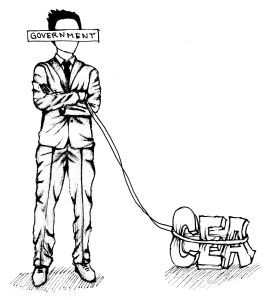The second the bell rings to signal lunch time, and eager freshmen hurriedly rush to the CEA while dreaming of the hot food. Backpacks swing from their shoulders as they squeeze against each other in a line that continues to grow. It is the second day of school.

Although some kind parents offered to make their children’s lunches on the first day for good luck, the second day marks a time for freshmen to buy their own food. They shove past one another to try to get their food before the mass of students situate themselves into a line. But this quick-paced, chaotic scene quickly disintegrates over the school year.
As the freshmen learn the ropes, many discover their dreams of steak sandwiches, perfectly tossed salads, and freshly-baked muffins are not what they had expected. The issue with the unpopular food isn’t that the CEA staff isn’t considering the desires of the student body, but rather that the staff is following the unreasonably restricting food regulations set by the state of California.
The U.S. Department of Agriculture “Smart Snacks in School” guidelines that took effect on July 1 of this year require that any food sold on campus during the school day must either be a whole-grain rich product, fruit, vegetable, dairy product, or protein food–or it can be a combination of food with at least a quarter cup of fruits or vegetables.
Eating a well-balanced, nutritious meal is important for growing teenagers. I’m a big proponent of health-conscious and nutritious eating, but I believe that the California state government should not force others to eat healthily.
When students are forced to take a side of veggies with their entrees because of Title 5, California Code of Regulations, sections 15575-15578, many swiftly throw out their baby carrots on their way out the door. Because of ever-increasing food regulations, students at Redwood are wasting more food than they would if they had solely received the entree that they wanted.
America’s unhealthy eating habits must be addressed, but forcing students to eat a certain way is not the right way to approach the issue. Instead of serving a meal or snack with a side of veggies, individuals should get the freedom of choosing what type and amount of healthy food to purchase.
High schoolers are at the age when they are fully capable of deciding what to eat and drink; this choice is crucial because they need to learn how to eat a balanced diet instead of simply having it handed to them. Furthermore, high school students will need to be able to make healthy decisions in our future, so why not start now?
Shouldn’t individuals have the freedom to choose what food they purchase and consume? When a student wants to order a tomato, basil, and mozzarella panini, they are forced to also take a side of veggies. This must be changed.
Many students only eat the food that they want from the CEA, which is why it isn’t beneficial to either the students or the CEA when the staff are forced to serve food items that are not in demand.
Recently, the CEA brought back bagels by popular demand, and chocolate chip cookies will be returning soon. The CEA should be allowed to operate like this more often; items should be sold according to what students want, rather than what the government wants.
Supply needs to meet demand or else customers will turn to other alternatives, and this principle is demonstrated at Redwood by the fact that many students go out to lunch nearby since they don’t like the food served at the CEA.
California should cut back on school-related food regulations. With fewer restrictions, the CEA could supply food that students and staff want. By supplying the cafeteria with food that students and faculty demand, the CEA would gain an increase in revenue. Most importantly, the students and staff would enjoy the food that they eat.






